Two Straight-Tubed Choices for the .300 Blackout – and Other Calibers
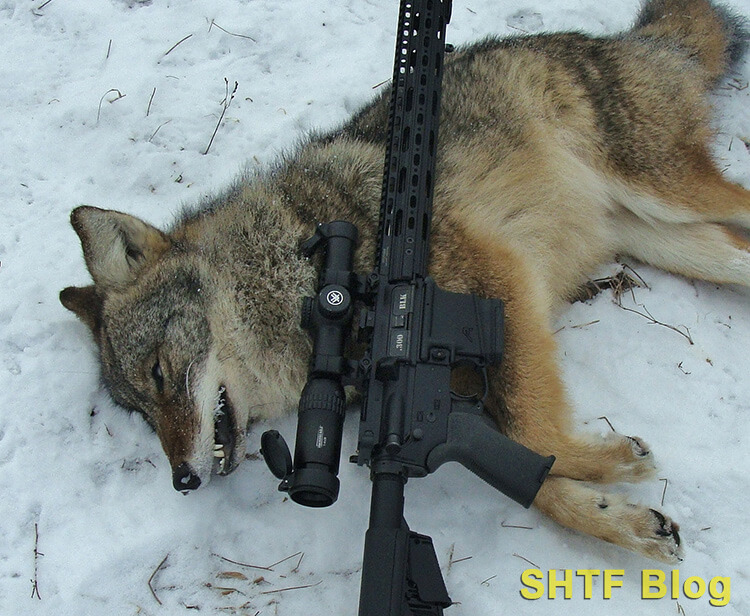
My review of the Vortex Strike Eagle series of scopes comes with years of real life experience. Here’s one example.
January 2019, I was coyote hunting two days before the full moon and three hours after sunset. The dark shape of a coyote materialized in my binoculars, headed toward an active bait pile located 85 yards from my blind. I carefully opened a window, poked out my AR-15, and began searching for the coyote through the scope.
No luck at first but then suddenly there he was, clearly silhouetted against the snowy background beside the bait. I pasted the illuminated crosshairs on the coyote’s chest and squeezed off a shot. The quiet subsonic bullet hit its mark and flattened him on the spot with an audible impact.
Lights out, compliments of the .300 Blackout conversion, using Hornady’s Subsonic 190-grain SUB-X load. The coyote, a large male, would no longer be chasing deer through our deep winter snow.
Normally, I’d be using an AR-15 with a night vision scope, but this hunt was a bit of an experiment. Two days prior, I’d returned to the warmth of the house after a long and fruitless nighttime vigil in the same drafty blind. The sky was clear, fresh snow had recently fallen, and the field behind the house was bathed in moonlight.
That got me to thinking (scary thought) about the use of a lighter weight alternative to my night scope as a way to save weight during hikes through deep snow to a blind. To find out, I ran inside long enough to grab a similar .300 Blackout AR-15, equipped with a Vortex 30mm 1-6×24 Strike Eagle.
- The updated Strike Eagle 1-6x24 is defined by speed and versatility. A true 1x on the low end adapts to a wide range of scenarios, letting users engage from close to extended ranges
- The magnification ring has been updated and now includes a thread-in throw lever, and the magnification indicators can now be seen without coming off the scope.
- The new illuminated BDC3 reticle focuses the user's eye faster and holdovers allow for immediate use out to 650 yards for targets of known distance.
- The fast focus dial on the eyepiece allows for quick and easy reticle focusing. Anti-reflective coatings on all air-to-glass surfaces provide increased light transmission for greater clarity and...
With temps in the low teens the comparison didn’t last long, but it was, as they say, revealing. The night-scoped AR obviously had the edge. However, the Strike Eagle performed much better than expected. I had no trouble resolving several objects at around 100 yards and the crosshairs were entirely usable, even on their lowest illuminated setting.
This simple test was also educational. I’d owned this straight-tubed scope for more than two years, but its use for nocturnal coyote missions had never crossed my mind. It was really purchased because of its reticle, which offered possibilities for .300 Blackout loads. Results were better than expected, too.
Vortex Strike Eagle Scope Series
Vortex has become a major player in the crowded field of firearms-related optics. They now catalog an extensive line of scopes, dot-sights, and other optics at various price points. Their scope line is especially diverse, encompassing everything from entry-level versions to high-end tactical models.
The Strike Eagle series is full notch above the former but nowhere near the latter versions. Nevertheless, for the money, the 1-6 version I’ve been using seems to outperform its cost. I ran into this happy situation with another Vortex scope provided for a review; a 4.5-16×44 Diamondback Tactical (read the review).
The Strike Eagles are a tier above the Diamondbacks. The Vortex site list three versions; a 5-25×56 FFP (34mm tube), 1-8×24, and the 1-6×24 that I’ve been using. Although the straight-tubed 30mm Strike Eagles are larger than many smaller 1-inch variables designed primarily for hunting, they do a credible job of bridging the gap between higher-magnification scopes and dot sights.
I don’t have any experience with the 5-25×56 model; however, a few trusted connections report good results with their 1-8x24s. Same story for my 1-6X24 so that’s where we’ll begin.
A quick note first: Vortex has recently “updated” these scopes. Main changes appear to be a different reticle pattern, and inclusion of a throw-lever for fast magnification changes. The latter is a logical addition. Beyond sporting and tactical uses, the straight-tubed Strike Eagles always seemed like an affordable ticket to fast-paced 3-Gun type events.
The 1-6×24 Strike Eagle
As mentioned during reviews of other Vortex products, one feature I always appreciate is their packaging. The pertinent specifications are printed right on the box (see the photos for details). Inside, a few welcome extras are packed with the scope. One is a useful set of hinged rubber lens caps, suitable for storage or actual field use.
Another is a CR2032 battery needed to power the illuminated reticle. Mine also included a spare battery, a lens cloth, and very concise set of directions. The latest versions, advertised as “updated”, ship with a separate throw-lever. The one on hand here doesn’t have that feature but works well enough without it.
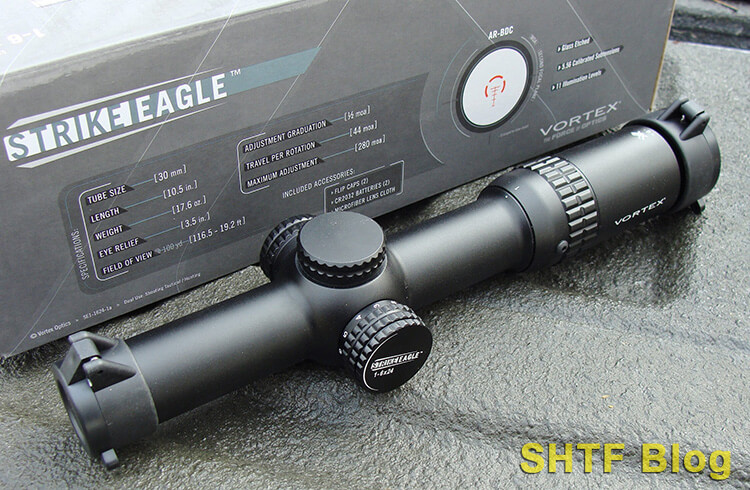
Specs
The 1-6 weighs 17.6 ounces, heavier than some equivalent 1-inch hunting scopes, but right in the ballpark for similar 30mm versions. Length is 10 ½ inches. Field of view (FOV) is a very wide 116.5 feet on 1x, and 19.2 feet on 6x. Eye relief is 3 ½ inches. Although not overly long, the straight-tube design of provides extra ring spacing latitude.
Also, many will wind up on flat-top ARs with plenty of additional rail space and adjustable stocks. The eyepiece is a fast-focus design. Vortex advertises the exterior lenses as coated with “Armor Tec” to improve scratch resistance. No complaints from me regarding clarity. These scopes are parallax corrected for 100 yards.
Turrets
Both are low-profile capped versions. Instead of using slots, their outer edges are knurled for finger adjustments. The stems are surrounded by radial scales with half-MOA hashmarks that also incorporate numbers in 4-moa increments. The corresponding ½ MOA clicks are positive and the 30mm tube provides an extremely generous 140 MOA of adjustment per turret.
Reticle
The Illuminated reticle is glass-etched etched, meaning it’ll work with or without a battery. Mine is the original AR-BDC 1 MOA version advertised with “5.56 calibrated subtensions.” The pattern resembles an inverted Christmas tree (with four hold-over lines), and the upper part is surrounded by a bolder 270-degree circle.
If the scope is set to 1X and the reticle is illuminated, the expansive FOV pretty much duplicates a dot sight. Because this scope is a second-focal plane design, its values remain consistent regardless of the magnification setting. As noted above, the updated versions feature a different pattern, although they still function similarly.

Illumination
The combination battery cap/numbered power knob is located on the left side of the turret saddle. The battery cover can be unscrewed via fingers for access to the CR-2032 battery. Each number provides a progressively brighter red reticle that starts with very faint settings. Unlike the latest upgraded version, my entire reticle illuminates. There are 11 settings in all.
Footnote: After shooting the above coyote, I played with reticle’s illuminated settings. Between the moonlight and snowy background, turned out I could’ve made the shot even with a dead battery.
Also, the Strike Eagles are advertised as waterproof, and come with the Vortex lifetime warranty.
Mounting
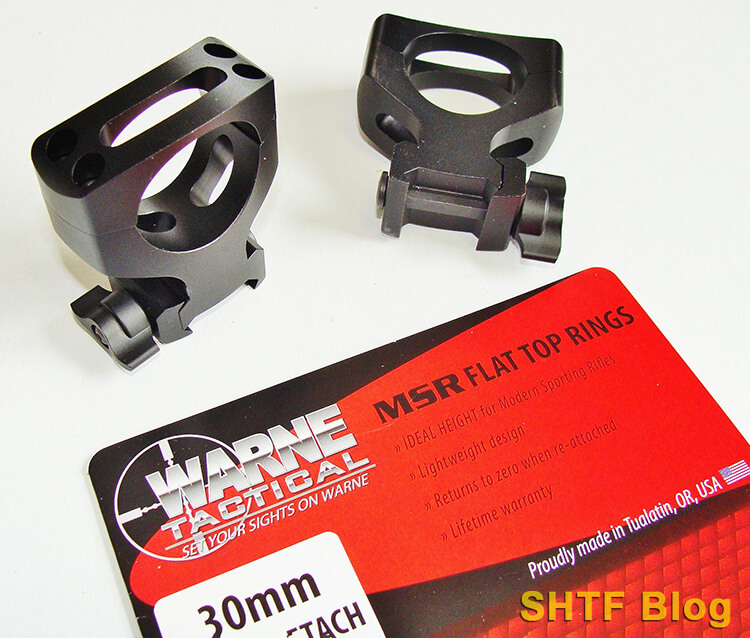
Although suitable one-piece mounts were on hand I was after a two-piece system. This option would allow some weight savings and provide rail space for a QD brass-catcher mount. Most of my .300 BLK shooting involves handloads formed from shortened .223 cases, a process so labor intensive that I hate losing brass.
Based on results with other Warne products, I chose a set of 30mm MSR Flat Top Rings. These lightweight aluminum rings are designed for ARs. They also feature a QD thumbscrew system for easy installation or removal without any appreciable loss of zero. The scope mounted without a hitch, nicely centered above the QD gadget.
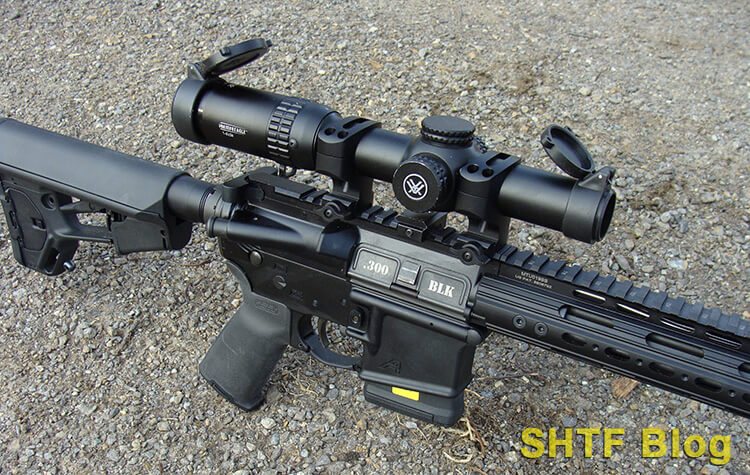
Eagle Eyes for the .300 Blackout
Circling back to my experimental coyote hunt, nocturnal bait and blind strategies are driven by the weather and moon. With clear skies in the forecast and a full moon coming on, there was no time to waste if I wanted to try the Strike Eagle. Fortunately, although I’d be switching AR-15s, their QD muzzle adapters accepted the same suppressor.
The intent was to use the same quiet 190-grain SUB-X loads as well, rated at 1050 fps. However, the Strike Eagle was zeroed for my “default” 110-grain Hornady V-MAX handload that clocks 2350 fps. Normally, the necessary re-zero would require some shooting but, thanks to the features of the scope, two quicker fixes were available.
Turret Solutions
Time was wasting so I simply unscrewed the elevation cap and came up 26 clicks past “0”, the equivalent of 13 inches at 100 yards – one heck of a lot of drop! But that’s what it takes to compensate for heavy subsonic bullets that fly like bricks. After recapping the turret, I simply switched ARs.
Through previous on-range research, I knew the come-ups would put me on the money at 100 yards with SUB-X, as far as I care to shoot any loopy subsonic .300 Blk load. The proof was in the coyote, laid low from a spot-on hit.
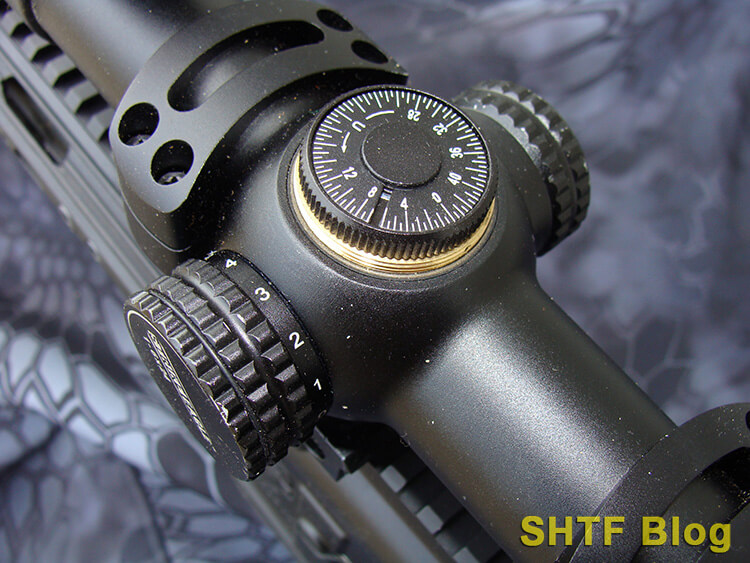
Once the moon went by, it was easy enough to dial the turret down to its previous setting. Here’s where generous elevation pays off: Because a full rotation provides 44 MOA, I had no worries about getting “lost” during multiple revolutions. After less than a third of a turn I was back home, zeroed for the supersonic load.
This is an extremely useful benefit for those of us who shoot loopy calibers with widely disparate trajectories. This range of adjustment is also less common among lower-magnification straight-tubed scopes.
Will my 1-6 Strike Eagle’s ½-MOA turrets provide repeatably useful adjustments at extreme ranges? I dunno, but as far as I’m concerned it’s a moot point. Even if using supersonic loads, the furthest I plan on shooting it is 200 yards.
Or The Reticle – In A Pinch
The turrets have proven repeatable for my purposes but, actually, I could’ve switched to subsonics without touching them. As noted above, I chose the Strike Eagle in part because of its trajectory-compensating reticle. Although calibrated for 5.56 NATO velocities, on-range experimentation revealed it can also cover the full gamut of .300 Blackout loads.
It’s doable through a combination of the scope’s 2nd focal-plane reticle, and adjustments to its magnification. Today’s 1st FP reticles are gaining popularity because they offer consistent values regardless of the scope’s magnification setting. The values of 2nd FP designs change, but that isn’t always a bad thing.
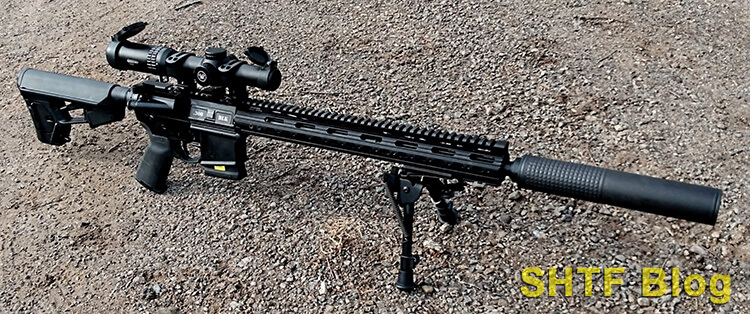
In this case I discovered I could make 100-yard hits with loopy subsonics through the magic combination of 4.75X and the reticle’s 3rd hold-over line. It’s a handy trick for use on the fly. For more information related to this process, I’ve included a link to an earlier post on bullet drop compensation.
Vortex Strike Eagle “Review” Process
Normally, as part of a scope review, I’ll verify consistent turret adjustments by “shooting the square” during an on-range tracking test. Additional groups are fired to note any impact shifts resulting from magnification changes. Of course, weatherproofing, clarity and low-light checks are also part of the process.
But, as far as I’m concerned, these boxes have already been checked through several years of use, to include various loads and critters. Coyotes top the current list, but the process began much earlier on one frigid November morning…
During the 2017 deer season, just as legal daylight dawned, a whitetail buck trotted into view at 70 yards and paused just long enough for a fleeting shot. The scope was set to 4X and its illuminated reticle was set to “off”, but I had no trouble lining him up in the crosshairs. When the shot broke the deer traveled a short distance but then tipped over from a spot-on hit.
The bullet, a Barnes solid-copper 110-grain TAC-TX, was never recovered – which comes as no surprise. These expanding monolithics penetrate beyond their weight and have since accounted for several more deer to round out my trio of favorite Blackout loads.
The Barnes load sees the least use, however, after dialing up two clicks beyond “0”, it’ll shoot to the same place as the above 110-grain Hornady V-MAX load. If both are sighted in to strike 1 ½-inches high at 100 yards, they’ll hit that amount low at 200 yards – my personal outer limit for this caliber. Once deer season ends, it’s time to re-zero the Strike Eagle for Hornady’s subsonic SUB-X loads.
Three useful Blackout options using the same affordable scope, which so far, has held up well in some pretty harsh conditions.
Latest Versions, Including the 1-8×24
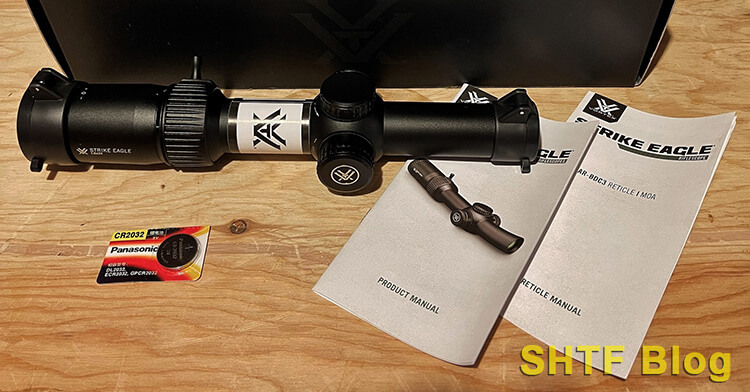
I bought my 1-6 Strike Eagle before the 1-8 version was released. It works well enough that I have no inclination to switch (it still has the original battery. Today though, I’m guessing more folks will be interested in the 1-8, which shares the same features in a scope of similar size and weight (see photos).
Either way, the latest Strike Eagles will probably ship with the upgraded reticle. If so, it should still work with .300 Blackout loads while allowing hasty hold-over solutions for subsonics.

If using supersonic or subsonic loads, zero per normal on the scope’s maximum magnification setting. At further distances, bullets should impact somewhere within the reticle’s grid. You should be able to merge the shot-group with a hold-over line through adjustments to the scope’s magnification (see below).
If using both load options, zero per above with the supersonic load (+ 1 ½” at 100 yards works). Next, while maintaining the same aiming point, fire a subsonic group (100 yards recommended). If the subsonic group develops on a white background, you should be able to see it through the scope after circling the hits with a black marker.
Aim at the bullseye again and, while maintaining that hold, adjust the magnification until a hold-over line coincides with the group. There’s your 100-yard correction.
If zeroed exclusively for subsonics, the same trick can be used to compensate for their steep mid-range trajectories by sighting in at 50 yards. From there shoot groups in 25-yard increments to gather the necessary data (mine covers 125 yards). The 2nd FP reticle offers lots of possibilities for tailored use of oddball loads.
Closing Comments
Of course, the above techniques can also cover more common calibers. After all, the present AR BDC3 reticle is designed for .223/5.556 loads. Also, .308/7.62×51. It even incorporates a small ranging scale above the main aiming system. To help sort everything out Vortex ships these scopes with a useful Reticle Manual.
Some will complain about the coarse ½ MOA adjustments, but they’re plenty good for the .300 Blackout and, for all calibers, they’ll never be further than ¼” off at 100 yards.
The reticle is busier than the earlier version but still useful. It also incorporates a central dot. The 1-MOA dot and its surrounding ring are the only parts that illuminate. The result on 1X is an image quite similar to a dot-sight.
List price for the latest 1-6×24 SE is $500. The 1-8×24 lists for $600. But both can be found for much less. All things considered including the transferable lifetime warranty, for these prices you could do a lot worse.

